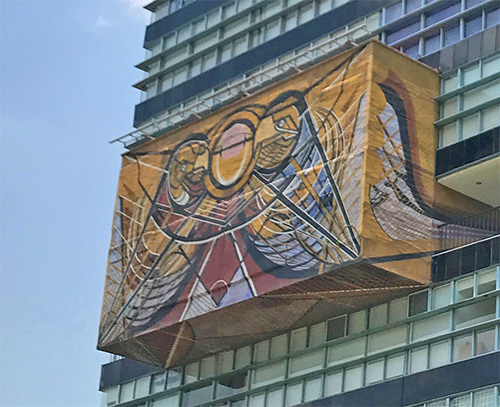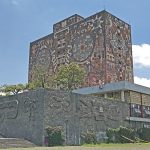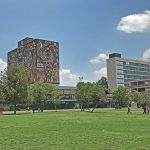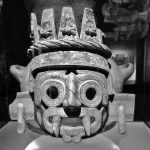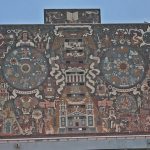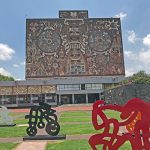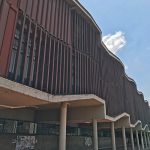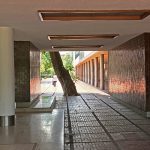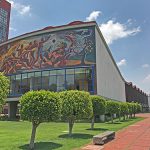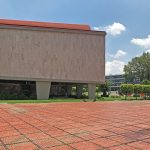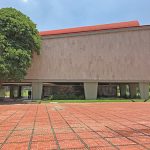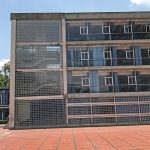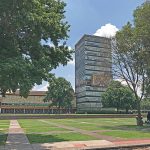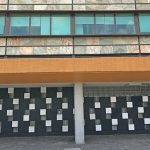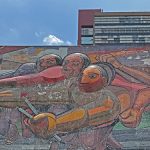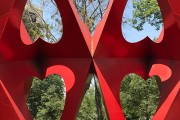
Mexico’s UNAM Campus: Revolution Past and Present
by Rebecca Firestone with Mark English AIA | Editorials
Mesoamerican motifs and revolutionary ideals live on in a dynamic fusion, at the Universidad Nacional Autónoma de México campus in Mexico City – an independent university with a rich and deep cultural heritage.
Image courtesy Mark English Architects.
“Like other examples of Mexican architecture, everything seems to suggest that there is a second layer underneath the surface.” Mark English described his impressions of a university campus that he visited this past June. “UNAM is layered so that there is more than what meets the eye.”
The National Autonomous University of Mexico, or Universidad Nacional Autónoma de México, is an independent university founded in 1910, and built up over the succeeding decades with contributions from many leading artists and architects of the day. Motifs from past and present adorn many of the campus buildings, and a nearby sculpture park is a UNESCO World Heritage site.

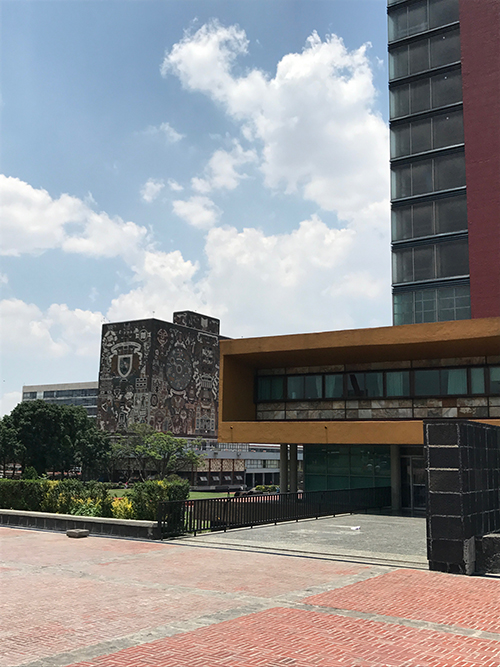
Entry to the university. “The university is one huge quadrangle, entered from above with long, wide rows of steps leading down, mimicking the urban spaces of the Aztecs… like a giant outdoor room, with legible propaganda displayed on the buildings around the edges.” Image: Mark English Architects
Although Mark did not visit the sculpture park, I would definitely recommend including it in your walking tour for its monumental earthworks built around lava flows.
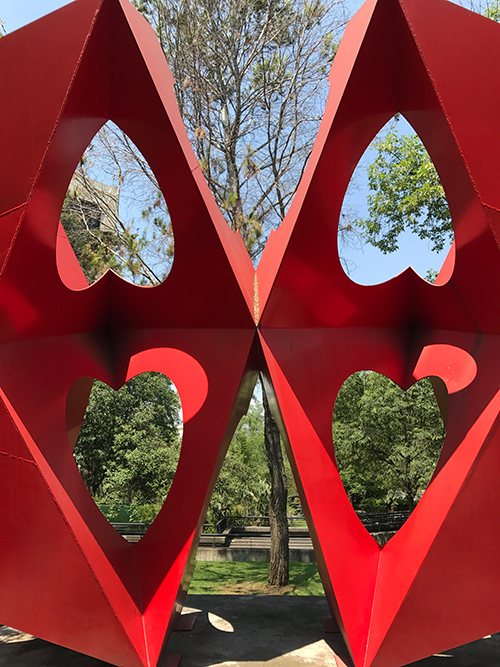
They’re not hearts, they’re circles that look like hearts at certain points around the sculpture, cut into perpendicular fins in the sculpture. “Another layer of surprise… less overtly masculine than works by Richard Serra or Henry Moore. Their works are so iconic that they have become almost fetishized. This work seems more playful.” Image: Mark English Architects
The university’s designs were influenced by Functionalism as an architectural approach, which at one time informed anthropology, psychology, and the sciences. Summarized, it’s “the theory that all aspects of a society serve a function and are necessary for the survival of that society…” or one that views society “as a system of interdependent parts whose functions contribute to the stability and survival of the system”.
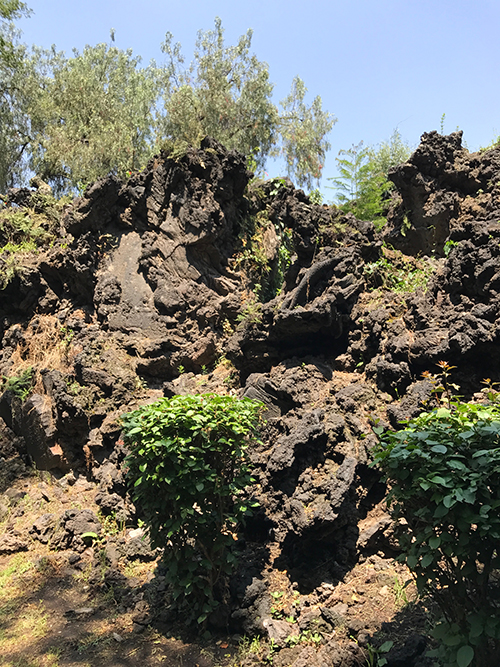
Landscape of lava on the UNAM campus. “This shows how insecure the foundation is, underneath its apparent permanence. Mexico City is built on lava flows, and on top of a filled-in lake. This lava flow is evidence of recent geological violence.” Image: Mark English Architects
This holistic regard for the past holds great meaning in a place with so much archaeological evidence of pre-Colombian greatness.
Education as an Act of Defiance
“Education itself is a revolutionary act.” Mark was talking about a mural by artist David Alfaro Siquieros of a giant hand with a pencil, with several dates shown from 1520 to 19?? [sic]. The years represent significant historical dates, some of which match up with standard timelines for Mexican historical events. For example, 1520 was the Spanish conquest of the Aztec empire, and 1810 saw a defeat of Spanish troops by insurgent forces.
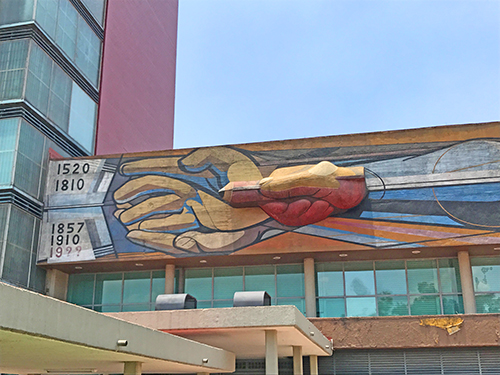
This mural by David Alfaro Siquieros of a giant hand with a pencil embodies the revolutionary expression that also informs much of Brazilian Modernism, suggesting that education itself is a revolutionary act. The last date shown reads as “19??” Image: Mark English Architects
Another building was the Rectory Tower, by architects Mario Pani, Enrique del Moral and Salvador Ortega Flores. Like many of the other campus buildings, it’s a pretty ordinary-looking high-rise with the exception of a decorated pop-out about halfway up.

Rectory Tower building with pop-out room. You can see the hand mural to the right. “The pop-out feature caught my attention. It just squirts right out of the building.” Architects: architects Mario Pani, Enrique del Moral and Salvador Ortega Flores. Image: Mark English Architects
Central Library
The most striking building is probably the Central Library, or Biblioteca Central. The mural is credited to architect and painter Juan O’Gorman, working with architects Gustavo María Saavedra and Juan Martínez de Velasco. A cosmic view spans the atomic age, European culture, and pre-Colombian history as a continuum, each with equal importance.
The murals are composed of thousands of colored tiles, brought from all over the country. Each wall of the Central Library has a different historical focus:
- North Wall: Pre-Hispanic Past
- South Wall: Colony Past
- East Wall: Contemporaneous World
- West Wall: The University and Modern Mexico
The murals on the South wall of the UNAM Central Library were inspired by the representation of the Tlaloc, god of rain and fertility in the ancient Nahua-Culhua religion: the outer walls of foundational stone carry visible representations of this god. There is also a hidden representation of Tlaloc that is visible when the building is viewed frontally from the south.
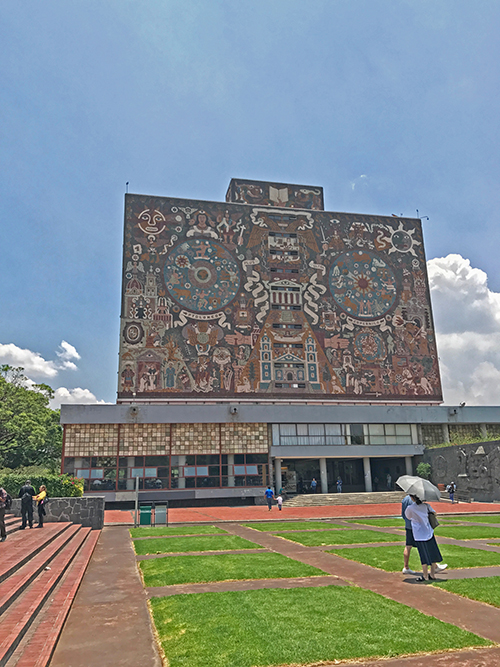
Central Library. “This is modern architecture with specifically ancient mix of Spanish and Indian motifs.” The Aztec deity Tlaloc, god of rain and fertility, appears in several places. Image: Mark English Architects
O’Gorman describes how he created the mural:
“The general theme of the mural is related to the evolution of culture. In the upper part I represented the cosmological symbols; In the north wall, figures allusive to the pre-Hispanic culture; On the south wall, I developed the argument about colonial culture; On the sides, I referred to the modern age, and on the east side, I represented the atom as cosmological symbol of our century. On the west side I had originally projected the Newtonian concept of universal attraction, but I had to vary it by having to represent there the university shield with the corresponding motto, which, in my opinion, should have gone in the rectory building”
(English version provided by Google Translate)
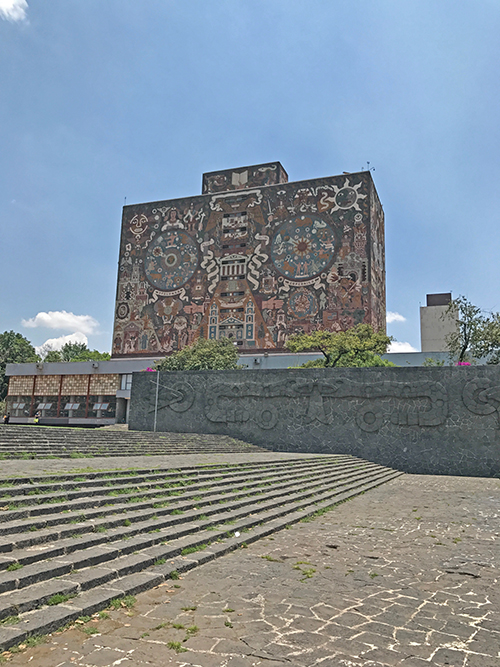
Central Library with stone steps. “There’s an ancient feel to these steps. The wall has an Aztec design of two snakes meeting face to face.” Image: Mark English Architects
Another aspect of Functionalism is the emphasis on direct experience, and applied fieldwork, as opposed to an educate elite writing up second-hand memoirs based on hearsay, working from 19th-century ivory towers. In some way, the Aztec motifs are still real, and immediate, even though the Aztecs themselves no longer exist as a sovereign nation.
Gallery
- Library showing another side of the foundational wall, built of carved volcanic rock. Image: Mark English Architects
- Library, east wall. The atom as cosmological symbol for the atomic age. Image: Mark English Architects
- Image of Tlaloc , from Latin American Studies Organization. Compare to south wall of Central Library.
- Close-up of the south wall mural. Image: Mark English Architects
- This photo shows the Mesoamerican deity Tlaloc’s hidden representation through an optical illusion. The two large circles are the eyes, the nose is the lower part, and the entrance doors are the mouth. (Bike sculptures in the foreground are part of a more recent “pro-bike” initiative to reduce air pollution.) Image: Mark English Architects
Architecture Building
The School of Architecture at UNAM offers undergraduate and postgraduate studies in architecture, landscape architecture, urbanism and industrial design. This building hosts the undergraduate program, and was designed by architect José Villagrán.
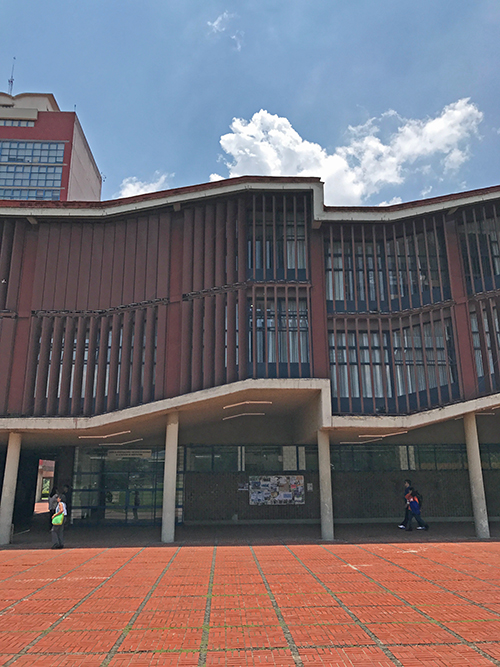
The architecture building, 180 degrees from the Central Library, undulates like a cosmic snake. “Like so many other practical buildings in Latin America, this utilizes brise soleil, or operable louvers, to control the sun’s heat instead of relying on energy-intensive cooling systems.” Architect: José Villagrán. Image: Mark English Architects
Image Gallery
- Side view of the architectural snake. Snakes are everywhere! Image: Mark English Architects
- Underneath the undulating arch in the architecture building. The tree re-appears in another few images. Image: Mark English Architects
- Mural on the architecture building is by José Chávez Morado. Image: Mark English Architects
Corbu’s Fingerprints – or Kahn’s?
Transitioning through the architecture building leads to a paved courtyard which to Mark English suggested le Corbusier. It reminded me of Louis Kahn’s work in India: “Even a brick wants to be something.”
Image Gallery
- Other side of architecture building. Paving is brick and volcanic rock. Image: Mark English Architects
- More paving. “To me, this shows influence of le Corbusier.” The tree from the underside of the architecture building. Image: Mark English Architects
- Turning from the architecture building. “There’s some interesting fenestration here, with the operable window openings and the glass blocks.” Image: Mark English Architects
- Main square, with our back to the architecture building. The Rectory Tower with the pop-out mural is in the distance off to the right. Image: Mark English Architects
- Approaching the Rectory Tower from the other side. What are those white dots? Image: Mark English Architects
- The articulated facade includes translucent onyx cladding that admits the light into the building. Image: Mark English Architects
- Aha, white dot mystery solved! Closer up, we see that the lower facade is actually a series of niches, which invite the creation of shrines. Image: Mark English Architects
- Mural with bas relief, by artist David Alfaro Siquieros. Image: Mark English Architects
Links for Further Study
Some links are in Spanish, and were translated using Google Translate.
- Wikipedia entry on UNAM
- Spanish Wikipedia entry on UNAM’s Central Library, including contributors
- Map of the UNAM campus that can be used as a guide for a walking tour, in Spanish
- Spanish article on Platforma Arquitectura, on UNAM’s Central Library, with more information on mural creator Juan O’Gorman
- Architecture credits for the Rectory Tower, in Spanish
- Spanish article on the murals on UNAM’s Central Library
- Wikipedia entry, Timeline of Mexican History
- Entry describing the Mesoamerican deity Tlaloc, from Latin American Studies Organization
- Wikipedia entry on Tlaloc. The cult of Tlaloc is older than the Aztecs.
- Travel destination article on UNAM, in Spanish
- A short “attractions” page on the UNAM sculpture park, including an address to visit. Time didn’t permit our tour to include this portion of the campus, unfortunately.
- Wikipedia entry on the UNAM School of Architecture
- A slideshow from Yatzer.com on Louis Kahn, titled “Even a Brick Wants to Be Something”.

